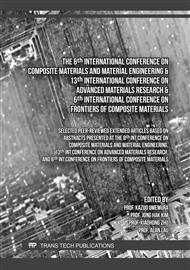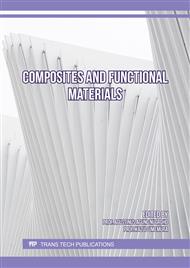[1]
Kabir MM, Wang H, Lau KT, Cardona F. Chemical treatments on plant-based natural fibre reinforced polymer composites: An overview. Compos Part B Eng. Elsevier Ltd; 2012; 43: 2883–92.
DOI: 10.1016/j.compositesb.2012.04.053
Google Scholar
[2]
Bledzki AK, Gassan J. Composites reinforced with cellulose based fibers. Prog Polym Sci [Internet]. 1999;24:221–74. Available from: http://ac.els-cdn.com/S0079670098000185/1-s2.0-S0079670098000185-main.pdf?_tid=af34542c-0260-11e7-a49c-00000aab0f27&acdnat=1488800173_c95596c7ddcc4673fe88c8ec84262bb9
Google Scholar
[3]
Rout J, Misra M, Tripathy SS, Nayak SK, Mohanty AK. The influence of fibre treatment on the performance of coir-polyester composites. Compos Sci Technol. 2001;61:1303–10.
DOI: 10.1016/s0266-3538(01)00021-5
Google Scholar
[4]
Jeyapragash R, Srinivasan V, Sathiyamurthy S. Mechanical properties of natural fiber/ particulate reinforced epoxy composites - A review of the literature. Mater Today Proc [Internet]. Elsevier Ltd.; 2020;22:1223–7. Available from: https://doi.org/10.1016/j.matpr. 2019.12.146
DOI: 10.1016/j.matpr.2019.12.146
Google Scholar
[5]
He Y, Wu D, Zhou M, Liu H, Zhang L, Chen Q, et al. Effect of MoO3/carbon nanotubes on friction and wear performance of glass fabric-reinforced epoxy composites under dry sliding. Appl Surf Sci [Internet]. Elsevier; 2020;506:144946. Available from:
DOI: 10.1016/j.apsusc.2019.144946
Google Scholar
[6]
Barrena MI, Gómez De Salazar JM, Soria A, Cañas R. Improved of the wear resistance of carbon nanofiber/epoxy nanocomposite by a surface functionalization of the reinforcement. Appl Surf Sci. 2014;289:124–8.
DOI: 10.1016/j.apsusc.2013.10.118
Google Scholar
[7]
Ding J, Rahman O ur, Peng W, Dou H, Yu H. A novel hydroxyl epoxy phosphate monomer enhancing the anticorrosive performance of waterborne Graphene/Epoxy coatings. Appl Surf Sci [Internet]. Elsevier B.V.; 2018;427:981–91. Available from:
DOI: 10.1016/j.apsusc.2017.08.224
Google Scholar
[8]
Vinod A, Sanjay MR, Suchart S, Jyotishkumar P. Renewable and sustainable biobased materials: An assessment on biofibers, biofilms, biopolymers and biocomposites. J Clean Prod [Internet]. Elsevier Ltd; 2020;258:120978. Available from:
DOI: 10.1016/j.jclepro.2020.120978
Google Scholar
[9]
Shukla N, Devnani GL. A review on mechanical properties of hybrid natural fiber polymer composites. Mater Today Proc [Internet]. Elsevier Ltd.; 2021;45:4702–5. Available from:
DOI: 10.1016/j.matpr.2021.01.122
Google Scholar
[10]
Sathish S, Karthi N, Prabhu L, Gokulkumar S, Balaji D, Vigneshkumar N, et al. A review of natural fiber composites: Extraction methods, chemical treatments and applications. Mater Today Proc [Internet]. Elsevier Ltd.; 2021; Available from:
DOI: 10.1016/j.matpr.2020.12.1105
Google Scholar
[11]
Lakshmi Narayana V, Bhaskara Rao L. A brief review on the effect of alkali treatment on mechanical properties of various natural fiber reinforced polymer composites. Mater Today Proc [Internet]. Elsevier Ltd.; 2021;44:1988–94. Available from:
DOI: 10.1016/j.matpr.2020.12.117
Google Scholar
[12]
Joseph P V., Joseph K, Thomas S, Pillai CKS, Prasad VS, Groeninckx G, et al. The thermal and crystallisation studies of short sisal fibre reinforced polypropylene composites. Compos Part A Appl Sci Manuf. 2003;34:253–66.
DOI: 10.1016/s1359-835x(02)00185-9
Google Scholar
[13]
Srinivasa CV, Bharath KN. Effect of Alkali Treatment on Impact Behavior of Areca Fibers Reinforced Polymer Composites. Int J Mater Mettalurgical Eng. 2013;7.
Google Scholar
[14]
Prabhu L, Krishnaraj V, Sathish S, Gokulkumar S, Karthi N, Rajeshkumar L, et al. A review on natural fiber reinforced hybrid composites: chemical treatments, manufacturing methods and potential applications. Mater Today Proc. Elsevier Ltd; 2021;45:8080–5.
DOI: 10.1016/j.matpr.2021.01.280
Google Scholar
[15]
Liu M, Meyer AS, Fernando D, Silva DAS, Daniel G, Thygesen A. Effect of pectin and hemicellulose removal from hemp fibres on the mechanical properties of unidirectional hemp/epoxy composites. Compos Part A Appl Sci Manuf [Internet]. Elsevier Ltd; 2016;90:724–35. Available from:
DOI: 10.1016/j.compositesa.2016.08.037
Google Scholar
[16]
Madsen B, Thygesen A, Lilholt H. Plant fibre composites - porosity and stiffness. Compos Sci Technol [Internet]. Elsevier Ltd; 2009;69:1057–69. Available from:
DOI: 10.1016/j.compscitech.2009.01.016
Google Scholar
[17]
Cruz J, Fangueiro R. Surface Modification of Natural Fibers: A Review. Procedia Eng. Elsevier B.V.; 2016;155:285–8.
DOI: 10.1016/j.proeng.2016.08.030
Google Scholar
[18]
Sosa RS, Millare J. Alkali treatment and Characterization of Nito Fiber. Mapua University; 2022.
Google Scholar
[19]
Deo C, Acharya SK. Effect of moisture absorption on mechanical properties of chopped natural fiber reinforced epoxy composite. J Reinf Plast Compos. 2010;29:2513–21.
DOI: 10.1177/0731684409353352
Google Scholar
[20]
Zin MH, Abdan K, Norizan MN. The effect of different fiber loading on flexural and thermal properties of banana/pineapple leaf (PALF)/glass hybrid composite [Internet]. Struct. Heal. Monit. Biocomposites, Fibre-Reinforced Compos. Hybrid Compos. Elsevier; 2018. Available from:
DOI: 10.1016/B978-0-08-102291-7.00001-0
Google Scholar



